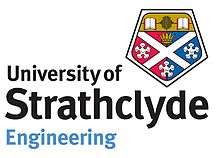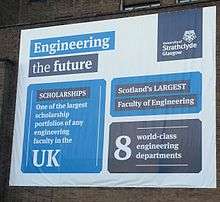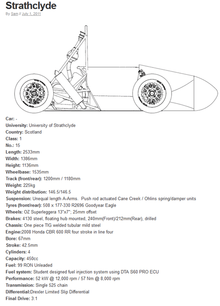University of Strathclyde Faculty of Engineering
The Faculty of Engineering is one of the four faculties which make up the University of Strathclyde[1] in Glasgow, Scotland. The faculty contains multiple departments offering many different undergraduate and postgraduate courses. These range from BEng, MEng and MSc courses to doctorates throughout the faculty.
 Older logo that has since been replaced |
Introduction

The Faculty of Engineering at Strathclyde is the largest of its kind in Scotland.[1]
It teaches over 4,000 students, who come from many different countries. 3,000 of these are undergraduates, 650 are postgraduates being taught, and 500 are at the university to do research.[2]
Departments
The faculty has eight departments. These are:
- Architecture
- Biomedical Engineering
- Chemical and Process Engineering
- Civil and Environmental Engineering
- Design, Manufacture and Engineering Management
- Electronic and Electrical Engineering
- Mechanical and Aerospace engineering
- Naval Architecture and Marine Engineering
Architecture
The department moved to the James-Weir building in August 2013.
Part of the department contains The Centre for Research in Sustainability and Design (CRiDAS). This is a centre that works on the implementation and improvement of technology to help reduce environmental and social impacts of buildings.[3]
Strathclyde was ranked the 11th best university for architecture in 2013[4] by TheCompleteUniversityGuide.
Biomedical Engineering
The Department of Biomedical Engineering is located at Wolfson Centre.[5] The Department incorporates the National Centre for Prosthetics and Orthotics which is one of only two institutions in the UK offering undergraduate and postgraduate education in Prosthetics and Orthotics. The Centre's interests in training, education and research span the fields of prosthetics, orthotics and related aspects of the provision of aids for the disabled.[5]
Chemical and Process Engineering
The Strathclyde University Department of Chemical and Process Engineering is located at James Weir Building.[6] Chemical Engineering at Strathclyde was rated the best in Scotland in the last Scottish Higher Education Funding Council Teaching Quality Assessment. All of the BEng, MEng and MSc courses are fully accredited by the Institution of Chemical Engineers.[6]
The Department also specialises in advanced computational modelling; looking at materials and processes on all scales from the atomic to the macroscopic. Strathclyde University Chemical and Process Engineering has been ranked 16th by Complete University Guide[7] and rated 13th by The Guardian[8] in 2013.
Civil and Environmental Engineering
Design, Manufacture and Engineering Management
Electronic and Electrical Engineering

The department is located within the Royal College of Science and Technology Building.
Department of Mechanical and Aerospace Engineering
The department of Mechanical and Aerospace Engineering is located in the University of Strathclyde's James Weir building.
The Department of Mechanical & Aerospace Engineering conducts research via its research centres and laboratories in Fluids, Energy, Aerospace engineering and Materials science: Aerospace Centre of Excellence (including Advanced Space Concepts Laboratory, Future Air-Space Transportation Technology, and Intelligent Computational Engineering Laboratory), Energy Systems Research Unit, James Weir Fluids Laboratory, Mechanics & Materials Research Centre.
Naval Architecture and Marine Engineering
The Department of Naval Architecture and Marine Engineering is located at the University of Strathclyde's Henry Dyer Building. The BEng and MEng courses are accredited by the Royal Institution of Naval Architects (RINA) and the Institute of Marine Engineering, Science and Technology (IMarEST) on behalf of the Engineering Council.[9]
Staff
Staff Numbers
As of July 2017 there were 23 key members of staff in the Faculty of Engineering (not including the staff of each department),.[10]
Dean of Faculty
The Executive Dean of the Faculty of Engineering is a Professor Atilla Incecik.
Research
Researchers at the Aerospace Centre of Excellence have led the €4 million, Europe-wide Stardust project, a research-based training network investigating the removal of space debris and the deflection of asteroids, and the first programme of its kind in the world. [11]
Competitions
A team of three students by the name of Team Hydra, composed of Eric Brown, Hugh McQueen and Theo Scott, developed and entered a solution to reduce the cost of passenger kilometers in Germany. The competition they entered the solution into was called the BP Ultimate Field Trip, they won the first prize and even the runners up were a combined team from Strathclyde and Glasgow.[12]
See also
References
- "University/department profile". Prospects.ac.uk. Retrieved 30 March 2014.
- "Engineering - University of Strathclyde". Strath.ac.uk. Retrieved 30 March 2014.
- Project by Ross Brown, website design by Alastair Cassell & doze. (19 April 2013). "Scottish Brutalism | Strathclyde School of Architecture – Frank Fielden & Associates, 1966". Scotbrut.co.uk. Retrieved 30 March 2014.
- "Architecture - Top UK University Subject Tables and Rankings 2014". Complete University Guide. Retrieved 30 March 2014.
- "Chemical Engineering (H801) - University of Strathclyde (S78) - Which? University". University.which.co.uk. Retrieved 30 March 2014.
- "Chemical Engineering - Top UK University Subject Tables and Rankings 2014". Complete University Guide. Retrieved 30 March 2014.
- "University guide 2013: league table for engineering: chemical | Education". theguardian.com. 22 May 2012. Retrieved 30 March 2014.
- "Championing the UK subsea sector - - Subsea UK, Aberdeen, Scotland". Subseauk.com. Retrieved 30 March 2014.
- "Our staff - University of Strathclyde". www.strath.ac.uk.
- "University of Strathclyde". Complete University Guide. Retrieved 30 March 2014.
- "The Journal - Strathclyde students enjoy engineering success". Journal-online.co.uk. 15 March 2013. Retrieved 30 March 2014.